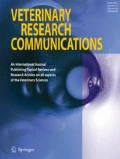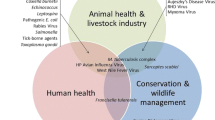Abstract
In recent years wildlife diseases (infectious and non-infectious) have played a relevant role in both wildlife conservation and public health. Global environmental changes have determined a bimodal evolution of wildlife. On one side a huge loss of biodiversity has been observed leading to the increasing of threatened or endangered species. In contrast few opportunistic taxa increased their aboundances and ranges. The above scenarios claim the intervention of wildlife veterinarians. In conservation the understanding of the ecological role of the host-parasite relationship and the perturbations on the host population dynamics have to be assessed and eventually modified. In public health the increased overlapping among wildlife, livestock, pets and human beings represents a risk for diseases spread (no matter in which directions). Serious limits are, still now, observed in the acceptance of this 'new world' by veterinary academics. As a consequence curricula often fail in providing adequate skill at both undergraduate and graduate levels. An addressed approach towards wildlife diseases should be promoted as an essential component of environmental management.
Similar content being viewed by others
REFERENCES
Artois, M., Delahay, R., Guberti, V. and Cheeseman, C., 2001. Control of infectious diseases of wildlife in Europe. Veterinary Journal, 162, 141–152
Boyce, W., Yuill, T., Homan, J. and Jessup, D., 1992. A role for veterinarians in wildlife health and conservation biology. Journal of the American VeterinaryMedical Association, 200(4), 435–437
Cleaveland, S., Hess, G.R., Dobson, A.P., Laurenson, M.K., McCallum, H.I., Roberts, M.G. and Woodroffe, R., 2002. The role of pathogens in biological conservation. In: P.J. Hudson, A. Rizzoli, B.T. Grenfell, H. Heesterbeek and A. Dobson (eds), The Ecology of Wildlife Diseases, (Oxford University Press, Oxford), 139–150
Cooper, M.E., 1993. Legal implications for the management of infectious diseases in captive breeding and reintroduction programs. Journal of Zoo and WildlifeMedicine. 24, 296–303
Crook, I., 1979. The profession and wildlife management. New Zeeland Veterinary Journal, 27(5), 85
Cunningham, A.A., 1996. Disease risks of wildlife translocations. Conservation Biology, 10, 349–353
Daszak, P., Cunningham, A.A. and Hyatt, A.D., 2001. Anthropogenic environmental change and the emergence of infectious diseases in wilfdlife. Acta Tropica, 78, 103–116
Deem, S.L., Karesh, W.B. and Weisman, W., 2001. Putting theory into practice: wildlife health in conservation. Conservation Biology, 15(5), 1224–1233
De Vos, V., van Rooyen, G.L. and Klopprs, J.J., 1973. Anthrax immunisation of free-ranging roan antelope (Hippotragus equinus) in the Kruger National Park. Koedoe, 16, 11–25
Ehman, K.D. and Scott, M.E., 2002. Female mice mate preferentially with non-parasitized males. Parasitology, 125, 461–466
Ferroglio, E., Tolari, F., Bollo, E. and Bassano, B., 1998. Isolation of Brucella melitensis from Alpine ibex. Journal of Wildlife Diseases, 34, 400–404
Garin-Bastuji, B., Oudar, J., Richard, Y. and Gastellu, J., 1990. Isolation of Brucella melitensis biovar 3 from a chamois (Rupicapra rupicapra) in the Shouthern French Alps. Journal of Wildlife Diseases, 26, 116–118
Gomper, M.E. and Williams, E.S., 1998. Parasite conservation and the black-footed ferret recovery program. Conservation Biology, 12(3), 730–732
Kreeger, T., 1982. Why wildlife? Minnesota Veterinarian, 22(1), 23–24
Laddomada, A., 2000. Incidence and control of CSF in wild boar in Europe. Veterinary Microbiology, 73, 121–130
May, R.M., 1986. The cautionary tale of the black-footed ferret. Nature, 320, 13–14
Meyer, M.E. and Meagher, M. 1995. Brucellosis in free-ranging bison in Yellowstone, Grand Teton and Wood Buffalo National Park: a review. Journal of Wildlife Diseases, 31, 579–598
Nettles, V.F., 1992. Wildlife diseases and population medicine. Journal of the American Veterinary Medical Association, 200(5), 648–652
Nielsen, N.O., 1992. Ecosystem health and veterinary medicine. Canadian Veterinary Journal, 33, 23–26
Osterhaus, A.D., 1988. Seal death. Nature, 334, 301–302
Primack, R.B., 2002. Essentials of Conservation Biology, (Sinauer)
Pullin, A.S., 2002. Conservation Biology, (Cambridge University Press)
Sainsbury, A.W., Kirkwood, J.K., Bennett, P.M. and Cunningham, A.A., 2001. Status of wildlife health monitoring in the United Kingdom. Veterinary Record, 148, 558–563
Sholley, C.R., 1989. Mountain gorilla update. Oryx, 23, 57–58
Tompkins, D.M., Dobson, A.P., Arneberg, P., Begon, M.E., Cattadori, I.M., Greenman, J.V., Heesterbeek, J.A.P., Hudson, P.J., Newborn, D., Pugliese, A., Rizzoli, A.P., Rosa, R., Rosso, F. and Wilson, K., 2002. Parasites and host population dynamics. In: P.J. Hudson, A. Rizzoli, B.T. Grenfell, H. Heesterbeek and A. Dobson (eds), The Ecology of Wildlife Diseases, (Oxford University Press), 45–62
Trainer, D.O., 1978. Wildlife disease – a profession? Journal of Wildlife Diseases, 14, 152–156
Valentincic, S., 1976. Il ruolo dei parassiti nell'ecosistema naturale. Rivista di Zootecnia e Veterinaria, 2, 177–179
Viggers, K.L., Lindenmayer, D.B. and Spratt, D.M., 1993. The importance of disease in reintroduction programmes. Wildlife Research, 20, 687–698
Windsor, D.A., 1995. Equal rights for parasites. Conservation Biology, 9(1), 1–2
Woodford, M., 1965. The role of the veterinarian in wildlife conservation. Veterinary Record, 77, 1311–1317
Woodford, M. and Rossiter, P.B., 1993. Disease risks associated with wildlife translocation projects. Revue Scientifique et Technique Office International des Epizooties, 12, 115–135
Author information
Authors and Affiliations
Corresponding author
Rights and permissions
About this article
Cite this article
Lanfranchi, P., Ferroglio, E., Poglayen, G. et al. Wildlife Veterinarian, Conservation and Public Health. Vet Res Commun 27 (Suppl 1), 567–574 (2003). https://doi.org/10.1023/B:VERC.0000014219.29166.37
Issue Date:
DOI: https://doi.org/10.1023/B:VERC.0000014219.29166.37




